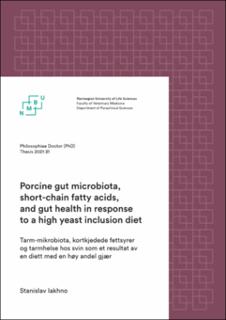| dc.contributor.advisor | Sørum, Henning | |
| dc.contributor.advisor | Umu, Özgün | |
| dc.contributor.author | Iakhno, Stanislav | |
| dc.date.accessioned | 2023-03-06T15:26:37Z | |
| dc.date.available | 2023-03-06T15:26:37Z | |
| dc.date.issued | 2021 | |
| dc.identifier.isbn | 1894-6402 | |
| dc.identifier.issn | 1894-6402 | |
| dc.identifier.uri | https://hdl.handle.net/11250/3056180 | |
| dc.description.abstract | The results of the PhD project have shown that high inclusion of Cyberlindnera jadinii yeast in pig feed exerts a prebiotic‑like effect. Beneficial intestinal lactic acid‑producing bacteria increase in numbers following feeding the novel diet. It seems that small intestine lactobacilli play a pivotal role in enabling yeast protein for pigs. Altogether, high levels of dietary yeast support animals. It does so by offering an extra layer of protection against enteric infections common in young pigs.
The porcine industry needs a source of protein to provide for the growing human population of the globe. The production of soybean, a conventional protein in livestock diets, contributes to environmental deterioration. Protein derived from a sustainably produced C. jadinii yeast is an alternative to soy. The yeast feed fulfils the nutritional needs of pigs. But also, it can influence the composition of the gut microbiome in animals. The gut microbiome plays an important role in the well‑being and robustness of animals. This role becomes even more relevant when animals are young and exposed to pathogens before specific immunity has developed.
The C. jadinii cell wall contains non‑digestible carbohydrates that are not accessible to the animal. These carbohydrates are available for microbial fermentation in the microenvironment of the gut. The microbial metabolites such as short‑chain fatty acids contribute to gut homoeostasis. Previously it has been studied how dietary yeast can change the gut microbiome and health in pigs. However, little is known about the effects of yeast inclusions at the level that it can replace conventional protein sources.
In this PhD project, it was investigated how a diet with 40% of crude protein replaced by protein from C. jadinii influences the gut microbial composition. The health‑related parameters linked to the gut microbial composition were studied.
The microbial compositions were explored by using cultivation and the 16S rRNA bacterial gene sequencing techniques; the microbially‑produced short‑chain fatty acids were measured by gas chromatography. The histology techniques were used to elucidate the morphology of the gut.
It was found that the composition of the gut microbial community was reshaped by the novel diet owing to its rich content of beta‑glucans, mannan‑protein, and chitin. These changes were distinct for distinct gut segments. Host‑associated lactobacilli were found to be enriched in the microbiomes of healthy yeast‑fed piglets. The findings suggest that lactobacilli enable pigs to take up protein from yeast cell by disrupting the cell yeast cell envelope.
Then, the piglets were challenged with enterotoxigenic Escherichia coli. The microbial diversity of the small intestine was higher in the yeast‑fed piglets compared with that of the control‑fed piglets.
The caecum and colon microbiomes were less diverse and were predominated by Prevotella‑affiliated taxa in the yeast‑fed piglets compared with the control‑fed piglets. Surprisingly, the distal part of the large intestine microbiome had the opposite trend. The colonic microbiota of the yeast‑fed piglets had a lower population of butyrogenic bacteria, lower concentrations of butyrate, and shorter colonic crypts than those of the control‑fed piglets. These differences in metabolites and morphology were associated with a healthy gut state. More, the yeast‑fed piglets exhibited reduced feed intake after being exposed to E. coli infection. This suggests the development of an adaptation that secures animal survival following the severe enteric infection.
Our findings motivate an upscaling of this research framework to a field‑wide level. By doing so, a realistic estimate for the economy and environment following the use of the novel feed can be obtained. | en_US |
| dc.description.abstract | Resultatene fra PhD‑prosjektet har vist at høy inkludering av Cyberlindnera jadinii gjær i grisefôret utøver en prebiotika‑lignende effekt i grisene. Godartede melkesyreproduserende bakterier i tarmen øker i antall etter fôring med den nye dietten. Det ser ut til at melkesyrebakteriene i tynntarmen spiller en nøkkelrolle i å tilgjengeliggjøre gjærproteinet for grisene. Samlet viser det at høye nivåer av gjær i dietten støtter dyrene. Det skjer ved at det blir dannet et ekstra nivå av beskyttelse mot tarminfeksjoner som er vanlig hos unge griser. | en_US |
| dc.language.iso | eng | en_US |
| dc.publisher | Norwegian University of Life Sciences, Ås | en_US |
| dc.relation.ispartofseries | PhD Thesis;2021:31 | |
| dc.rights | Attribution-NonCommercial-NoDerivatives 4.0 Internasjonal | * |
| dc.rights.uri | http://creativecommons.org/licenses/by-nc-nd/4.0/deed.no | * |
| dc.subject | porcine gut microbiota | en_US |
| dc.subject | 16S rRNA sequencing | en_US |
| dc.subject | microbial ecology | en_US |
| dc.title | Porcine gut microbiota, short-chain fatty acids, and gut health in response to a high yeast inclusion diet | en_US |
| dc.title.alternative | Tarm-mikrobiota, kortkjedede fettsyrer og tarmhelse hos svin som et resultat av en diett med en høy andel gjær | en_US |
| dc.type | Doctoral thesis | en_US |
| dc.relation.project | Foods od Norway The Research Council of Norway, Lysaker, Norway, grant number 237841/030 | en_US |

